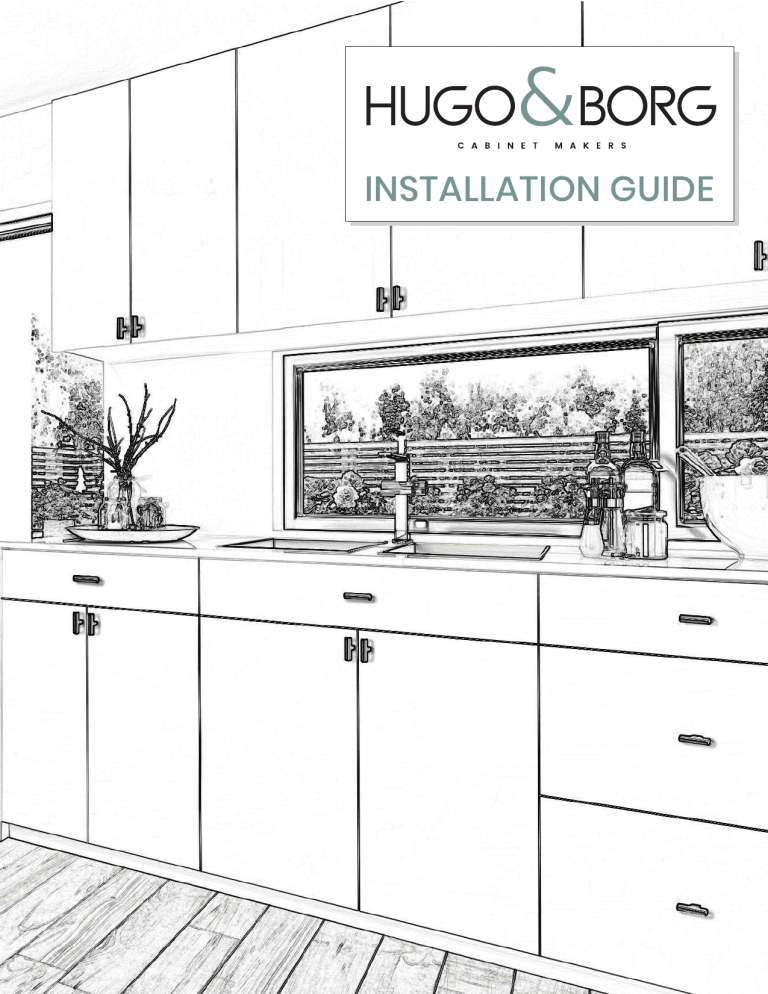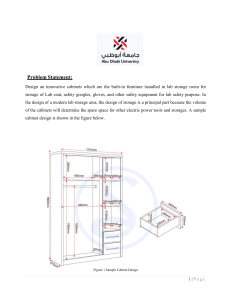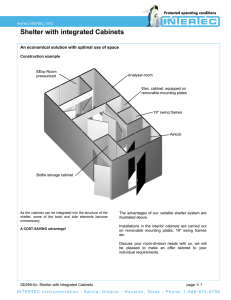
INSTALLATION GUIDE 1 IMPORTANT NOTICE! FOR YOUR SAFETY AND THE LONGEVITY OF YOUR NEW HUGO&BORG CABINETS, PLEASE FOLLOW THE INSTRUCTIONS BELOW: CABINETS SHOULD ALWAYS BE MOVED BY TWO PEOPLE. REMOVE ALL DOORS, DRAWERS AND ADJUSTABLE SHELVES PRIOR TO MOVING ANY CABINET. ALL CABINETS NEED TO BE COMPLETELY INSTALLED TO THE WOOD STUDS BEFORE PUTTING ANY ITEMS INSIDE THE CABINETS. TABLE OF CONTENTS 1. SAFETY & LIABILITY .................................................................................................................................................................. 3 2. TOOLS & SUPPLIES ................................................................................................................................................................. 3 3. INSTALLATION ........................................................................................................................................................................... 4 Getting Started ........................................................................................................................................................ 4 Installation ................................................................................................................................................................... 5 Fillers ................................................................................................................................................................................ 7 Sink/Cooktop .............................................................................................................................................................. 7 Base & Base Blind Corner Cabinets ....................................................................................................... 8 Dishwasher Gables ............................................................................................................................................... 9 Crown Moulding ...................................................................................................................................................... 9 Appliances .................................................................................................................................................................... 9 General Installation Information ............................................................................................................. 9 Adjusting Door Hinges & Drawer Fronts .......................................................................................... 10 2 1. SAFETY AND LIABILITY The decision has been made to install the cabinets and accessories yourself. This installation guide is meant to assist you in the general installation process. The installation of cabinetry can be a challenging task and we do recommend that you use a qualified cabinet installer. However you may have the skill-set to complete the installation on your own. HUGO&BORG has no control over the installation, so you are responsible and liable for completing the installation correctly and safely. SAFETY AND LIABILITY DISCLAIMER: Please note that the following instructions are only a guide to cabinet installation. HUGO&BORG will not be liable for any damage to cabinets, cabinet hardware, flooring, walls, etc., due to improper installation or mishandling of cabinets. o reduce the risk of serious or fatal injury, read and understand this installation guide T before commencing with the installation. This HUGO&BORG installation guide is not intended to cover every possible contingency that might be encountered during installation or to endorse the use of any particular tool. HUGO&BORG hereby expressly disclaims all warranties and all liability for any claims for injury or death related to or based upon the use of this installation guide. A qualified service professional should be used for any electrical or gas line work. All gas, electrical and water connections must be shut off in any work area. ITEMS THAT YOU SHOULD CONSIDER: Do you have experience with carpentry and cutting miters? R equired tools: for a quality installation you will require several tools. They can be expensive and require experience to operate in a safe and efficient manner. Condition of the site: floors are level, and walls are square and level. Basic plumbing and electrical skills may also be required. It is recommended that there are two people to install the cabinets. 2. TOOLS AND SUPPLIES The following may or may not be required depending on the complexity of your installation: • UL approved safety goggles, steel-toe shoes and earplugs. • Drill and bits, compressor, pin nailer and nails. • • • • • • • Table saw, miter saw and jig saw. Clamps, levels, squares, straight edge and line levels. Extension cord, lighting and ladders. Stud finder, handle jig and circuit tester. Tape measure, screwdrivers, hammer pencil and masking tape. Installation wood screws (1 1/8" and 2 1/2") and screw caps (for wood stud construction). Carpenter glue. 3 3. INSTALLATION UNDERSTANDING OUR CABINET CODES (EXAMPLES). All measurements will be referred to in imperial. CODE DESCRIPTION W1830 Wall cabinet 18" wide and 30" high WA2430 Wall angle corner cabinet 24" wide and 30" high B30 Base cabinet 30" wide with 2 doors and 1 top drawer, 34 1/2" high UC1584 Utility cabinet 15" wide and 84" high GETTING STARTED • • • • • Check to make sure the cabinets and accessories that you have received are what you ordered: if anything is not on site, then do not start your project until you have everything required. Double-check that you have all the required tools. Appliances should be moved to another room for easier maneuvering in the work area. Walls should be finished with the first coat of paint applied. Final flooring should be installed, including the areas that will have cabinets. 84" utility cabinet with 30" wall cabinet All dimensions are taken with the finished floor installed. 34 1/2" Please follow the next steps for the correct installation of your cabinets. 54" All cabinets should also be shimmed out from the walls to maintain a straight line. The "frameless" design of Hugo&Borg cabinets allows cabinets to be screwed directly together, creating a straight line, even if the wall is uneven. 84" It is common that finished floors are not perfectly level. All cabinets should be shimmed up from the floor level using wood or composite shims to the 34 1/2" line. 4 1 V erify that walls are square and level. Walls that are not square or level will make installation more difficult. You can use the 3, 4, 5 method shown to check your corner. 2 B efore beginning installation, you must first find the highest point of your floor by checking it with a level. 3 Use a stud finder to mark all the studs that will be used to install your cabinets. 4 D raw a level line at 34 1/2" from the highest point of your floor and another level line at 54" from the same point. Install the top of the base cabinets level with the 34 1/2" line, using shims to level the cabinets as needed. Install the bottom of the wall cabinets level with the 54" inch line. 5 S tarting with the corner wall cabinet, install (x4) 2 1/2" cabinet screws through the fastening strips on the cabinet into the wall studs. Be sure to check for level before fastening the cabinet into place. 5 Filler Wall corner 7 S et the next cabinet tight to the first cabinet and use clamps to hold in place while you level it and make sure that the front edges are flush. Attach the two cabinets together using 1 1/8" particle board screws. Attach the cabinet to the wall with 2 1/2" screws into the studs. Continue with the same process for all upper cabinets. 6 If you do not have a corner, start with the end closest to a wall, making sure to leave room for the required filler, as per your plan. Cleat Cleat 6" 6" 6" 6" 8 A lways start with the corner base cabinet, making sure it is level. Position the corner cabinet 6" away from the wall on both sides as shown. NOTE: the cabinet must have 6" of clearance from the back of the cabinet to each wall in order to align properly with the other base cabinets. For countertop stability, attach two cleats (or wood strips) using screws onto each wall as shown, ensuring their top edges align with the 34 1/2" mark. This will help support the weight of the countertop in the back corner. 6 Filler 9 F or designs without a corner cabinet, start with the first cabinet leaving space for a filler, as per your plan. 10 F or designs with a corner cabinet, set the next cabinet tight to the first cabinet and use clamps to hold it place while you level it, and make sure that the front edges are flush. Attach the two cabinets together using 1 1/8" particle board screws. Attach the cabinet to the wall with 2 1/2" screws into the studs. Continue with the same process for all base cabinets. FILLERS A filler is always required against a wall. To cut your filler, measure from the cabinet to the wall and cut the filler accordingly. Hold the filler in place; turn it over and on the back side make a pencil mark at the top and bottom where it should be cut. To prevent chipping when cutting fillers, place masking tape over the surface that is being cut. Join the two marks with a pencil line and saw along that line. Put the filler in place and drill a pilot hole at hinge-level through the cabinet and into the filler. Attach the filler to the adjacent cabinet by fastening together with wood screws. SINK/COOKTOP When installing a sink or cooktop, trimming the top support rails may be necessary. Using the template supplied by the sink or cooktop manufacturer, cut the top rails as required using a jigsaw. 7 BASE AND BASE BLIND CORNER CABINETS 43" - 62" BB45 L/R (base blind corner) cabinets may be pulled out from the corner if required and the room is available. BB45 L/R When installing a base cabinet at a right angle to a BB45 L/R cabinet you must use a filler to provide clearance for door and drawer handles. The filler width required is usually 1 3/4" - 3" depending on the type of pull used on the cabinets. Recommended void space is 6" Cut the 3" filler to required width. Fasten the filler to the two adjacent cabinets by drilling through the side of the cabinet into the filler. Screw together. Ensure cabinets are square in corner and attach the unit to the wall. Make sure all cabinets are plumb and level. Trim this side of the filler to make it fit #8 x 1 1 /2" screws The remaining base cabinets are installed in the same manner. Using the two C-clamps, align stiles, drill and screw together. Proceed around the room making sure all cabinets are plumb and level, shimming where necessary, then tighten all screws. Filler Install the remaining base cabinets by aligning the front of the cabinet edges. Clamp the cabinets together and attach using the 1 1/8" screws. Level the cabinet, adjust as required, and attach to the wall studs using 2 1/2" screws through the hanging rail located at the top of the base cabinet. After inserting the screws remove the clamps. BASE CORNER CABINET (BC3636) Base corner cabinets are placed 6" away from the wall on both sides, leveled and adjusted as required. They are secured in place by cabinets on either side. Counter-sink screws on BC3636 door handles. NOTE: the cabinet must have 6" of clearance from the back of the cabinet to each wall in order to align properly with the other base cabinets. 6" 6" Cabinet is installed with 6" clearance space from each wall 8 DISHWASHER GABLES Measure 27 1/8" over from the cabinet at the front and the back and draw a line on the floor. This will leave you 24 1/8" between the cabinet side and the start of the filler on the face of the dishwasher panel. Draw a plumb line on the wall from the floor to the base cabinet line. These lines mark the position of the inside of the dishwasher gable. Install a ledger board 27 1/8" long below the base cabinet guideline. The panel is then installed by attaching it to the ledger strip, floor and countertop with metal L-brackets. Ceiling CROWN MOULDING Crown moulding can be installed with a variety of methods, depending on the application. For Hugo&Borg "frameless" cabinets, crown moulding will always have to be attached to the top of the cabinet, as shown. 1" Variable 1 1/4" Sub-crown reveal variable APPLIANCES Today’s appliances are available in all shapes and sizes. Because of this, you must confirm opening sizes against the spec sheet provided with your paperwork, as well as the manufacturer's specifications. • Standard dishwasher openings are to be 24" wide (unless otherwise specified). • Standard range openings are to be 31 1/4" wide between base cabinets (unless otherwise specified). • • Standard fridge opening is 36" wide x 72" high (unless otherwise specified). Slide-in ranges: the opening and finished counter height is crucial when dealing with slide-in ranges. Type of flooring and countertop thickness have to be taken into account. Fillers or scribe on each side may be required to make sure drawers and doors clear the range. If base cabinets are set too low or high, the range will not sit flush with the countertop. Countertop top should be 36" unless otherwise noted. NOTE: Never attempt to move an appliance on finished flooring. Do not connect or disconnect any appliance that is hard-wired or connected to a water source. Always ask for help before attempting to move an appliance, as appliances are often heavy and there is a high risk of personal injury or property damage if not properly handled. GENERAL INSTALLATION INFORMATION • Install all cabinets level and plumb. • All cut-outs for piping should be as close to pipes as possible with a clean cutout edge. • Install bumpers on all door and drawer fronts, especially corner cabinets. 9 ADJUSTING DOOR HINGES Side Adjustment Using a Phillips screwdriver, rotate screw (1) clockwise to move the door left and counter-clockwise to move the door right. Moves the door up to 2 mm. Depth Adjustment Height Adjustment Using a Phillips screwdriver, rotate screw (2) clockwise to move the door forward and counter-clockwise to move the door backwards. Moves the door up to 2 mm. Using a Phillips screwdriver, rotate screw (3) clockwise to move the door upward and counter-clockwise to move the door downward. Moves the door up to 2 mm. ADJUSTING DRAWER FRONTS Up and Down Adjustment A tab is located on each side of the drawer bottom. For up/down adjustments, slide the tab left or right as needed. Adjusts the height (up/down) of the drawer front up to 2 mm. NOTE: drawer removal is not required or recommended for adjustments. Left and Right Adjustment Loosen each screw as shown and nudge the drawer front to the left or right as needed. Once the drawer front is in the desired spot, tighten each screw to secure. Adjusts the drawer up to 2 mm. Up and down adjustment Left and right adjustment Tabs Tab Loosen each screw before adjusting 10

